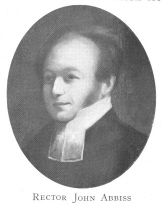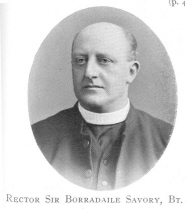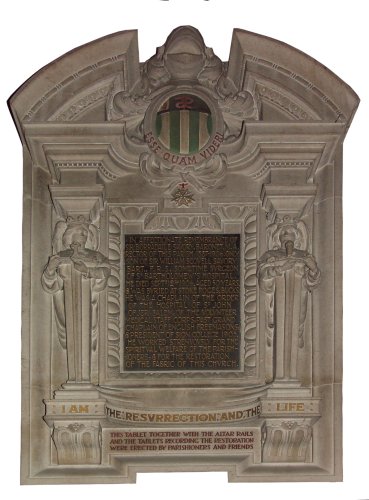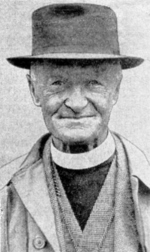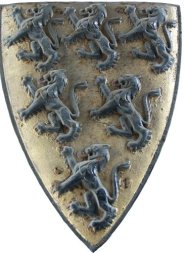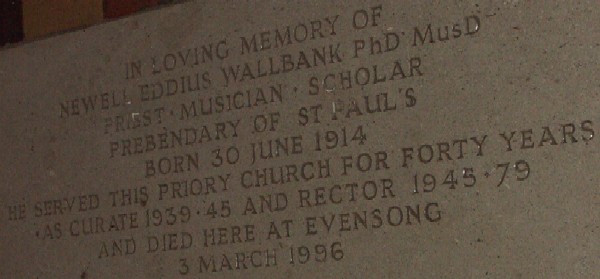
A Brief Note on Advowsons and Church Patronage
From the earliest days of Christianity in England, the nobility - who were at that time the only landowners - were encouraged to establish churches and monasteries. Bishops typically gave the founders of such an institution the right to select the cleric who would minister to the parish and manage its day to day activities and resources.This led to a formalized right for the secular founder of a religious institution to name the cleric in charge of that institution, with the corresponding duty to protect and maintain the church in case of hardship. This right is called the advowson of a particular church or monastery; the person who holds the advowson is referred to as the patron of the living.
From the early days, St. Bartholomew the Great enjoyed royal patronage from Henry I and his descendants. As part of its founding charter, St. Bart's was granted possession of a number of urban and rural churches, as described on the Advowsons page on this site.
The responsibility as "hiring manager" for the rector of a church, as well as more direct financial support when repairs or maintenance were necessary, keeps the patron involved with the daily adminstration of a religious institution. For that reason, I've included some information on the patrons of St. Bartholomew itself in this summary of its priors and rectors.
Priors, Priests and Rectors
Before the Reformation, a priory was one type of religious foundation, similar to a monastery or an abbey. Originally, priories were dependent organizations controlled by an abbey, but by the time of the Reformation the differentiation was minimal. The primary difference between abbeys and priories is that abbeys are ruled by abbots or abbesses, whereas priories are managed by priors or prioresses, but there's little difference between their rights and responsibilities. Priors were generally elected by the monks of the congregation, although the local bishop had some influence in the presentation of candidates.In the Church of England, a rector is the cleric in charge of a self-supporting parish, or a cleric who receives tithes directly, as opposed to a vicar, paid a salary by the diocese or other financial patron. This distinction is no longer strictly observed, and the two terms are roughly interchangeable based on local history and traditional usage. Rectors are generally chosen by the patron of the living, rather than by the parish or local church staff.
Augustinian Priors
|
Rahere |
1123 - 1143 |
|
Thomas |
1144-1174 |
|
Roger* |
cir 1176 - cir 1181 |
|
Richard* |
cir 1201 - cir 1206 |
|
G. of Osney* |
1213 - 1213 |
|
John (Blund) |
1226 - 1232 |
|
Gerard |
1232 - 1241 |
|
Peter le Duc |
1242 - 1255 |
|
Robert de Novo Loco |
1255 - 1261 |
|
Gilbert de Weledon |
1261 - 1263 |
|
John Bacun |
1264 - 1268 |
|
Hugh |
1269 - 1295 |
|
John de Kensington |
1295 - 1316 |
|
John de Pekesden |
1316 - 1350 |
|
Edmund de Broughyng |
1350 - 1355 |
|
John de Carleton |
1355 - 1361 |
|
Thomas de Watford |
1361 - 1382 |
|
William Gedeney |
1382 - 1391 |
|
John Eyton (alias Repyngdon) |
1391 - 1404 |
|
John Watford |
1404 - 1414 |
|
William Coventry |
1414 - 1436 |
|
Reginald Collier |
1436 - 1471 |
|
Richard Pulter |
1471 - 1480 |
|
Robert Tollerton |
1480 - 1484 |
|
William Guy |
1484 - 1505 |
|
William Bolton |
1505 - 1532 |
|
Robert Fuller, Abbot of Waltham |
1532 - 1539 |
*indicates a lapse in the church records after the given administration
Dominican Prior
|
William Perrin |
1556 - 1558 |
St. Bartholomew's was again surrendered to the Crown under Elizabeth I, 13 July 1559.
Post-reformation: the Rectors
|
John Deane
|
Parish Priest 1539 - 1544
|
|
Ralph Watson |
1565 - 1569 |
|
Robert Binks |
1570 - 1579 |
|
James Stancliffe, M.A. |
1580 - 1581 |
|
John Pratt, B.A. |
1582 - 1586 |
|
David Dee, M.A. |
1587 - 1603 |
|
Thomas Westfield, D.D. Bishop of Bristol |
1605 - 1644 |
|
John Garrett, M.A. |
1644 - cir 1655 |
|
Randolph Harrison, D.D. |
1655 - 1663 |
|
Anthony Burgess, M.A. |
1663 - 1709 |
|
John Pountney, M.A. |
1709 - 1719 |
|
Thomas Spateman, M.A. |
1719 - 1738 |
|
Richard Thomas Bateman |
1738 - 1761 |
|
John Moore, M.A. |
1761 - 1768 |
|
Owen Perrot Edwardes, M.A.
|
1768 - 1814 |
|
John Richards Roberts, B.D. |
1814 - 1819 |
|
John Abbiss, M.A. |
- According to Dungavell, Abbiss stifled efforts at restoring the church - especially in the latter part of his long tenure - because he was discouraged by the difficulty of fund-raising. |
1819 - 1883 |
||||
|
William Panckridge, M.A. |
- Presented to the living by Frederick Parr Phillips, the enthusiastic supporter of Webb's restoration. |
1884 - 1887 |
||||
|
Borradaile Savory, Baronet, M.A. |
- Presented to the living by Frederick Parr Phillips. FPP died March 1903, in Kensington. - Charles Booth interviewed Rector Savory as part of his survey of London; interview is available from the London School of Economics A description of Sir Borradaile from Booth's interview: "Sir Borradaile Savory is a man of perhaps 35 to 40, big, clean-shaven, well-groomed. He seems to be a man of simple and enthusiastic nature, who enjoyed his life, and would do his best to see that other people did the same. He is apparently rich [The Rector makes it a rule never to deliver a gift himself] , and last year spent nearly £850 in the parish. He is not particularly clever, I suppose, but is none the less a good fellow for that." - The 14 June 1893 issue of The Sketch includes this tidbit about Rev. Savory, in conjunction with the ceremonial opening of St. Bartholomew's north transept: "The Rev. Borradaile Savory, the popular and energetic Rector of St. Bartholomew the Great, West Smithfield, who, by-the-way, is the son and heir of the celebrated surgeon, Sir William Savory, is to be congratulated on the admirable restoration of his church, which is, perhaps, the most interesting ecclesiastical building in London. Since Mr. Savory's appointment, some years ago, he has worked most zealously to secure a reverend and artistic restoration of his grand old church, and the function last week, which was attended by royalty, was a fitting crown to his remarkable efforts." (pg. 347)
Sir Savory's memorial tablet is located on the north wall of the Lady Chapel. Monument text reads: "In affectionate remembrance of Sir Borradaile Savory, Baronet, M.A. Rector of this parish 1887-1906. Only son of Sir William Scovell Savory Bart., F.R.S., sometime surgeon of St. Bartholomew's Hospital. He died Sept 12th 1906, aged 50 years & was buried at Stoke Poges, Bucks. He was a chaplain of the order of the Hospital of St. John of Jerusalem, of the Volunteer Medical Staff Corps, past Grand Chaplain of English Freemasons; & president of Sion College 1905. He worked strenuously for the spiritual welfare of the parishioners, & for the restoration of the fabric of this church." Below the monument reads: "This tablet together with the altar rails and the tablets recording the restoration were erected by parishioners and friends."
St. Bartholomew's celebrated the centenary of Reverend Sir Borradaile Savory's death on 10 September 2008, including an evensong service and a special sermon by the rector. |
1887 - 1906 |
||||
|
William F.G. Sandwith |
- Presented to the living by Frederick Abbiss Phillips. When this Phillips died in Epsom (Surrey) in 1908, his widow (Mrs. Bowen-Buscarlet of Stoke d'Abernon) and their son (Noel McGrigor-Phillips of Wanborough Manor, Guildford) inherited the advowson. - Rector during the later part of Webb's restoration. - Reported to have seen a ghost in the pulpit of St. Bartholomew's, while showing two ladies around the building. (If you happen to have a reference for this story, please let me know!) |
1907 - 1929 |
||||
|
E. Sidney Savage |
- Canon Savage was a highly skilled fund-raiser and renovator: he restored Hexham Abbey before coming to St. Bartholomew, where he continued to improve the church and its properties after the death of Sir Aston Webb. - His book Rahere Yesterday and To-Day states the case for the various improvements Savage pursued, and provides a very chatty and personable introduction to the church as it was in the early 1930s. - According to Rahere Yesterday and To-Day, the patron during Canon Savage's tenure was Mr. Ivor Phillips (circa Feb 1930). Ivor Phillips is the last individual patron of the living whom I've been able to trace. |
1929 - 1944 |
||||
|
Newell E. Wallbank, Mus. D
|
- In 1951, the living of St. Bartholomew the Great came into the keeping of the Dean and College of Westminster, where it remains to this day. - According to James Savage, Canon Savage's great-grandson, Newell Wallbank was the Canon's godson (personal communication, 11 Sept 2008). - Father Wallbank died in St. Bart's itself, during an evensong service. An interview with Rev. Wallbank's widow, Phyllis
|
1945 - 1979 |
||||
|
Arthur Brown |
||||||
|
David Lawson |
||||||
|
Martin Dudley, BD MTh PhD FSA FRHistS AKC |
- present |
|||||
References
All early dates are taken from Webb's Records; dates for the twentieth century rectors are taken from the monument on the inside of the church porch.
Photographs of Rectors Abbiss, Panckridge, Savory and Sandwith are taken from Webb's Records vol. 2


|
